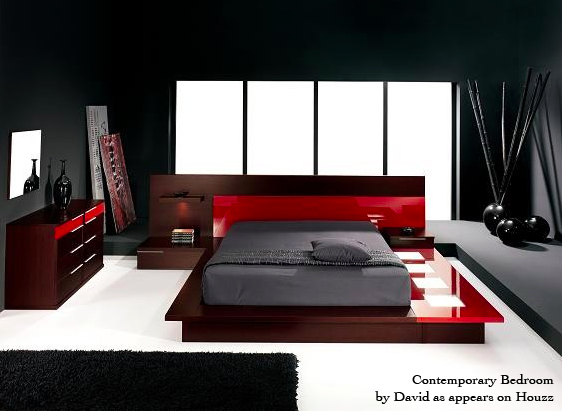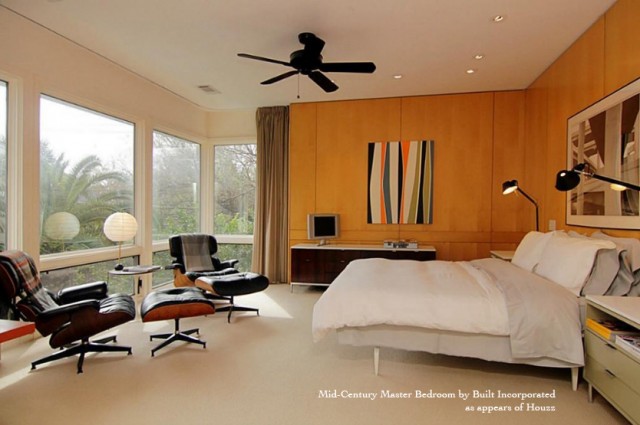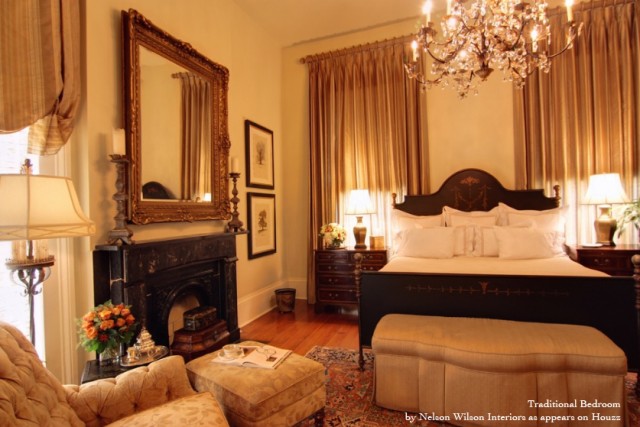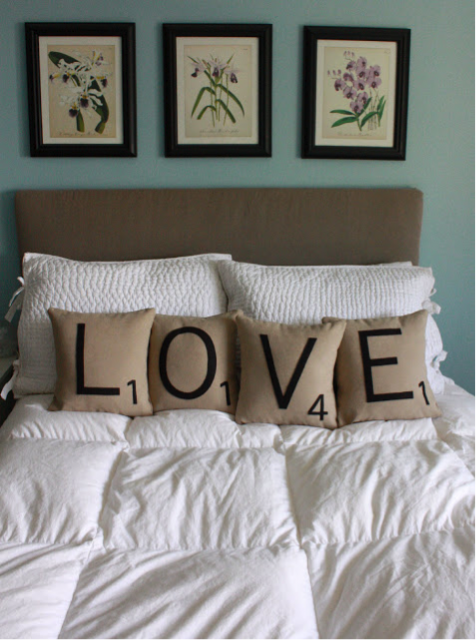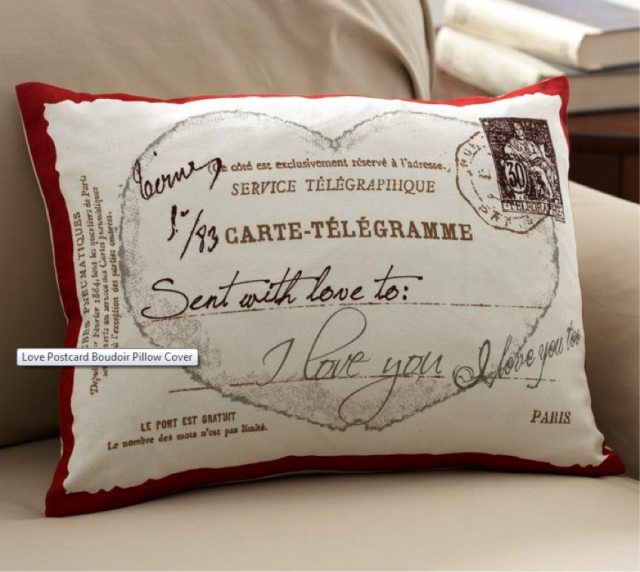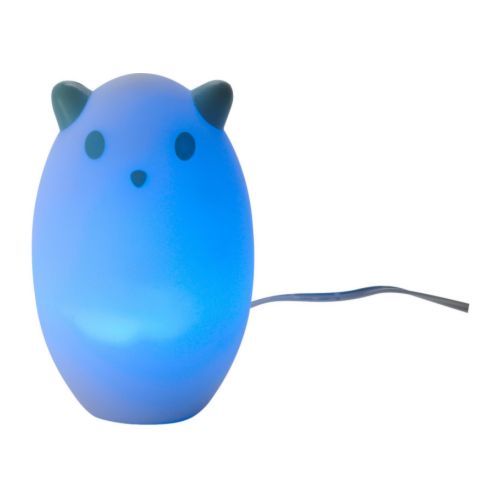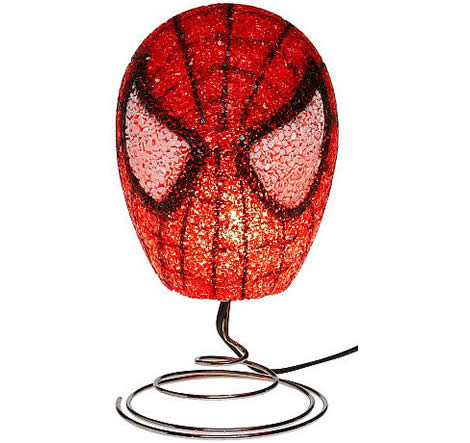Category Archives: Bedroom Design
Bedroom Design: Quick Change: A Tale of Two Lampshades
Post by Erin Sears.
In looking for ways to take my own bedroom design advice and begin again, I started assessing the contents of my bedroom. What do I love? What feels not-so-much? After taking a visual tour of the space, my eye kept getting stuck on my bedside lamps. The base of each lamp is fabulous (I am not humble about my own good taste), but one of the lampshades felt particularly ho-hum.
Here’s the story and what I did about it:
The first lampshade: Ordinary. Hard to clean and rapidly yellowing (gross). Similar to the one pictured below.
Source: lightingforum.com
Here’s the thing: Many lamps that you buy in mid-range home furnishing stores or from catalog outlets are great design choices, but they usually come with plain lampshades so that they can be easily integrated into the scheme of any room. But you don’t live in just ANY room, do you? Certainly not! You LIVE in YOUR rooms. Time to switch things up! (pun intended)
While I was back in the Midwest for the holidays, I took a trip to the Happiest Place on Earth, also known as Target, with my dear mother. Target has a new line of home goods called Threshold and I was instantly enamored with the look and quality of many of the products. In the lighting section, I stumbled across this beauty:
The second lampshade: Ombre glory. Sea and sand magic.
Source: target.com
Knowing it wouldn’t fit in my suitcase I put my ownership ambitions on hold and hoped that the lampshade could also be found at my local store. When I arrived it was in stock and for a cool 23 bucks it became MINE. And you know what? This little change has made all the difference. It easily took my bedroom design up a notch.
Here are some other gorgeous options for lampshades that really light me up:
Source: hillarythomas.com
Emily Wagner Handpainted Lampshade $99
Source: target.com
Threshold Blue Ikat Print Lampshade $22.99
Source: target.com
Threshold Mix and Match Trellis Shade $14.99
Source: Anthropologie.com
The Myriad Horizons Lampshade $98-$118
When in doubt, try a new lampshade! Really. Setting my sights on subtle bedroom design upgrades has proven to be transformative and oh-so-very pleasing. What can you switch up?
Bedroom Design: Contemporary vs. Modern vs. Traditional Design
Post by Kyle St. Romain.
While most people have a general idea of the way they want their bedroom to look, many use the wrong words when trying to describe this vision to other people. While minor differences in terminology go mostly unnoticed when talking amongst friends, the same words carry distinctly different meanings to professionals in the design community. To help you nail down the terminology, we’re going to discuss contemporary, modern, and traditional design and the main differences between each.
Contemporary Design
Contemporary design, also called transitional design, can be described as a mix of modern and traditional design. Unlike modern design, which describes a specific style from a particular era, contemporary design embodies what is “in” today. Indeed, the word contemporary means “with the time, “or “modern, characteristic of the present.” Contemporary can even be further described in terms of its geography. Thus, today’s contemporary design in California may be very different from today’s contemporary design in New York.
Some of the cornerstone elements found in contemporary design today include shiny, reflective surfaces like glass and stainless steel. Contemporary furniture is a bit bulkier and more rounded than modern furniture, but is more minimalistic than traditional furniture. Contemporary design often features very artistic lighting fixtures, which are commonly used as the statement piece in a room.
Modern Design
Modern and contemporary design are often confused and while they are similar, modern design refers to a specific era of design while contemporary design changes with the present. Modern design refers to an era of design from the mid 20th Century (1920s – 1970s) and many of the most famous furniture pieces and designers from this era are referred to as 20th Century Classics. Modern design incorporates clean lines, bright and open spaces, and the use of natural materials. During the mid 20th century, the idea of “form follows function” was prominent, and you’ll find that modern furniture is surprisingly comfortable—even if it doesn’t look like it will be.
Traditional Design
While it’s rare to confuse traditional design with modern or contemporary design, it’s important to briefly hit on traditional design since contemporary design often blends traditional with modern.
Traditional design often uses heavy, bold furnishings with rich earth tone colors such as brown, gold, or dark green. Traditional design is very ornate also, for example: claw foot chairs and embellished four post beds. Traditional pieces draw their inspiration from 18th and 19th century Europe. If you can picture it in a castle, it is likely traditional.
So there you have it: a brief introduction to contemporary, modern, and traditional design. Understanding the differences between these design styles, especially modern and contemporary, is important when describing your vision to interior designers, furniture sales people, and other members of the design community. As always, the best way to get a feel for design is to see how other people have done it.
What type of style do you like? What elements do you feel distinguishes these different design styles? Let us know in the comments below.
Bedroom Design:We ♥ Valentine Pillows
Post by Stephanie Noble.
The first rule of any design show makeover of a bedroom is more pillows! Not just the pillows you rest your head on while you sleep, but ambiance pillows of varying shapes, textures and patterns.
I’ll admit to being a reformed pillow fanatic. I wanted my bedroom to look like a hotel room every time I walked in. But, with a long commute, a full time job, a 19 month old son and a never ending stream of laundry to fold; my husband and I are lucky if the bed gets made. There is simply no time for complex pillow schemes. So we’ve streamlined our cushion display to three sleeping pillows each and a turquoise satin embroidered pillow. My great grandmother started the pillow in the 1920s. My grandmother worked on it at some point during the 1960s and my aunt finished it in the 1990s. This family treasure is the only decorative pillow in our cushion lineup.
That’s not to say I do not notice other pillows. I do, all the time. They are such a quick and easy way to freshen up a room. They’re also an easy nod to a holiday without going overboard. Although, I’m not a big fan of Valentine’s Day, I’ll admit to being attracted to Valentine pillows. Here are a few of my favorites.
These Scrabble-inspired pillows are all over Etsy.
This personalized tree initials pillow cover is available in five colors from Red Envelope.
This love postcard pillow cover is available online only from Pottery Barn.
It’s not too late to add a Valentine flair to your room.
Things We Like: Rhythmic Bedroom Design
Post by Kyle St. Romain.
A few weeks ago we discussed the various ways to achieve balanced design in your bedroom. To briefly recap, balance can be achieved in one of three ways: symmetrical, asymmetrical, or radial. Symmetrical balance is usually used in more formal spaces, while asymmetrical balance is often thought of as a more casual type of design. Radial balance can be either formal or informal, though it is most commonly used in dining arrangements where chairs are arranged in a circle around the dining table.
This week, I want to take a moment to discuss another fundamental principle of design, rhythm. Rhythm, also called repetition, is a way of timing your eyes’ movement through a space. While it is most often thought of in terms of music, rhythm is equally applicable to visual design. Rhythm is often the glue that holds the overall look of a room together.
Rhythm can be employed in a number of ways: linear rhythm, repetition, alternation, or progression—each of which will be discussed briefly below.
Linear Rhythm
Linear rhythm relies on the movement of the viewers’ eyes across an individual line. A simple way to think of linear rhythm is to picture a sunset over the horizon; the horizon is the linear line that draws your eyes across the image. In your bedroom, you may hang your pictures at a certain height to create linear rhythm, or have a large headboard with a flat top as a focal point of the room.
Repetition
Repetition involves the use of a particular pattern throughout a room to create a timing of movement across the room. Picture a wall with a lot of small pictures hanging very close to each other. Now picture that same room with fewer, larger pictures spaced further apart. In the room with the smaller pictures, your eyes would likely move swiftly across the room as they take in image, after image, after image, in quick succession. Contrast this with the larger, spaced out images: your eyes would likely move across the room much slower as each image commands more attention.
Alternation
Alteration is a specific type of pattern that relies on a particular sequence of repetition. For example, your décor could alternate between large and small objects, or light and dark colors. Alternation is different than typical patterning, as it is not necessary to recreate the exact element throughout the pattern. For example, you could alternate between gold and blue stripes throughout your room, with each stripe being of a different size.
Progression
Progression is achieved by gradually increasing or decreasing the characteristic of an element throughout the room. For example, you could place a set of vases linearly and arrange them according to size, or color.
When thinking about the rhythm of your bedroom, don’t limit your thoughts to one perspective of the room. Rather, you need to be mindful of the overall feel of the room. The best way to see how to successfully employ rhythm in your bedroom’s design is to see what other people have done. As usual, Houzz is an excellent resource for this, and you can browse rooms that scream rhythm here.
How do you use rhythm in your own design? Share your thoughts in the comments below.
Bedroom Design: Best Night Lights for Kids
Post by Mark T. Locker.
Ah, darkness. To the reasonable adult, it is a welcome thing, indicating that sweet sleep might be just around the corner. To a child, it is little more than cover for bone-crunching, blood-sucking monsters, just waiting to pounce on their unsuspecting prey. Thank goodness for night lights! My boy has a couple lights he uses. We have gone through many more during our years-long hunt for the perfect light. Here are a few of the more interesting lights I have seen. Spoiler alert: my favorite is the Ikea “Totoro” light.
This is the Spöka LED night light from Ikea. I love it. My son loves it. It reminds us a bit of Miyazaki’s Totoro. That is what my boy calls it. The best part about it is that is holds a charge which allows your kid to take it to bed if so desired. My kid so desires. It’s even kind of soft! Also, it changes color, from blue to green and everything in between.
I found this turtle light at the Goodwill and it put me back a whole $2.99. I was skeptical whether it would actually project stars on the ceiling but it really does. It’s pretty great. It stays lit for about half an hour and works like a charm.
Spider-Man’s decapitated head on a spring. I thought this would scare the bejeezus out of my son, but he actually likes it. Go figure.







